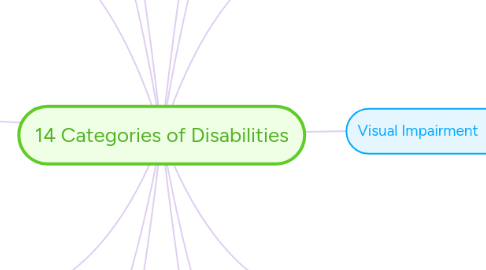
1. Developmental Delay
1.1. Intervention
1.1.1. Prepare strategy sheets to learn a skill, that is captured in a checklist. Checklist includes key steps to master that skill (Extended Learning).
1.2. Modification
1.2.1. For cognitive delay, use student's preferences and interests to build lessons (Extended Learning).
1.3. Assistive Technology
1.3.1. When using a computer keyboard, place stickers on target keys when using computer programs.
2. Hearing Impairment
2.1. Intervention
2.1.1. Specialized seating arrangements and clearly enunciate speech.
2.2. Modification
2.2.1. Provide supplemental materials to reinforce concepts that are being taught.
2.3. Assistive Technology
2.3.1. Amplification device: enhance residual hearing (Aboud).
3. Multiple Disabilities
3.1. Intervention
3.1.1. Appropriate therapists work closely with classrooms. Include language development, social skill development, functional skill development and vocational skill development in the classroom (Paths to Literacy).
3.2. Modification
3.2.1. Modify books to meet the needs of students (Paths to Literacy). For example, enlarging text and simplifying context.
3.3. Assistive Technology
3.3.1. Talking Photo Albums: Conversation aid for individuals with limited verbal communication skills (Paths to Literacy).
4. Orthopedic Impairment
4.1. Intervention
4.1.1. Special seating arrangements to develop useful posture and movements (ProjectIDEAL, 2013).
4.2. Modification
4.2.1. Adjustment to rules regarding absences due to disability (ProjectIDEAL, 2013).
4.3. Assistive Technology
4.3.1. Communication devices, like a communication board (ProjectIDEAL, 2013).
5. Other Health Impairment
5.1. Intervention
5.1.1. (Ex. ADHD) Teach specific techniques for organizing their thoughts and materials. Organize classroom accordingly, keep materials in permanent locations (ProjectIDEAL, 2013).
5.2. Modification
5.2.1. (Ex. ADHD) Simplify steps of more complex assignments to make them more manageable.
5.3. Assistive Technology
5.3.1. (Ex. ADHD) Noise cancelling earphones.
6. Intellectual Disability
6.1. Intervention
6.1.1. Use different color chalks/pens for emphasis on different topics.
6.2. Modification
6.2.1. Change learning tasks to something with a similar topic by simplifying or condensing, or combing or grouping information (Students with Intellectual Disabilities).
6.3. Assistive Technology
6.3.1. Computer software to help facilitate improved spelling and literacy skills (Students with Intellectual Disabilities).
7. Emotional Disturbance
7.1. Intervention
7.1.1. Support student's inclusion. Environmental disturbance can make it hard for peers to build or maintain interpersonal relationships (Emotional Disturbance).
7.2. Modification
7.2.1. Break down assignments into smaller ones. As students complete each step, build in reinforcement for task completion (Emotional Disturbance).
7.3. Assistive Technology
7.3.1. The Talklight: Light flashes according to noise in the room. This can help students settle down or transition into another activity (Emotional Disturbance).
8. Specific Learning Disability
8.1. Intervention
8.1.1. Resource room that provides special services for specific academic subjects (HealthyChildren.Org, 2015).
8.2. Modification
8.2.1. Students get graded using a different standard than the other students (HealthyChildren.org, 2015).
8.3. Assistive Technology
8.3.1. Listen to audio recordings instead of reading text.
9. Speech/Language Impairment
9.1. Intervention
9.1.1. Core Vocabulary Therapy: Student is given a list of words and their production is tested twice weekly (Bowen, 2014).
9.2. Modification
9.2.1. Allow the student to substitute oral assignments with written assignments (Bowen, 2014).
9.3. Assistive Technology
9.3.1. Augmentative and Alternative Communication Device (AAC). Helps make it possible to overcome communication problems (Bowen, 2014).
10. Traumatic Brain Injury
10.1. Intervention
10.1.1. Give attention to the physical arrangement of the classroom to make mobility easier and accommodate physical needs.
10.2. Modification
10.2.1. Change in class schedules to a less demanding course load.
10.3. Assistive Technology
10.3.1. Screen readers that read aloud the words on the screen.
10.4. Case Study
10.4.1. http://www.researchgate.net/profile/Carl_Coelho2/publication/7489053_Behavioral_and_social_interventions_for_individuals_with_traumatic_brain_injury_a_summary_of_the_research_with_clinical_implications/links/00b7d53bed6ea2d8fe000000.pdf
11. Visual Impairment
11.1. Intervention
11.1.1. Sit student near the blackboard in a central location, verbalizing as you write (American Foundation for the Blind).
11.2. Modification
11.2.1. Extended time completing assignments (American Foundation for the Blind).
11.3. Assistive Technology
11.3.1. Low vision devices that help students see objects near and objects at a distance (American Foundation for the Blind).
12. Deaf-blindness
12.1. Intervention
12.1.1. Provide specialized and highly individualized communication and educational support to student (Blaha).
12.2. Modification
12.2.1. Extra time to complete assignments.
12.3. Assistive Technology
12.3.1. BrailleNote: a note-taking device that can have notes outputted in braille, print, or speech (Blaha).
13. Autism
13.1. Intervention
13.1.1. Students taught social skills in one on one or in small group settings (Stokes).
13.2. Modification
13.2.1. Provide trained peer support or a buddy system to assist with social interaction and provide additional support as needed (Stokes).
13.3. Assistive Technology
13.3.1. Computer touch screens to allow students to navigate and interact with the computer (Wright, 2001).
13.4. Case Study
13.4.1. http://sgo.sagepub.com/content/spsgo/4/4/2158244014556640.full.pdf
14. Deafness
14.1. Intervention
14.1.1. Language Therapy
14.2. Modification
14.2.1. Visual learning opportunities to compensate for lack of auditory stimuli (Mader, 2012).
14.3. Assistive Technology
14.3.1. Alerting device: Provides information through vision or vibration (Heckendorf, 2009).
14.4. Case Study
14.4.1. http://pediatrics.aappublications.org/content/106/3/e43.full.pdf+html

